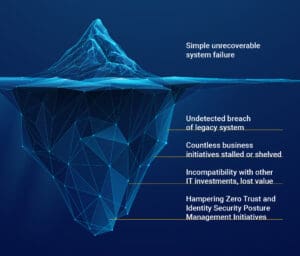Modernizing Your Legacy Identity Infrastructure is Finally Possible
- Wade Ellery
- April 22, 2025
- Identity Security Posture Management
- 5 MIN READ

I will admit that I tend to hold on to things too long. My children live in fear of having to clear out my garage one day, wondering with each odd bolt and piece of PVC pipe, “Why did Dad keep this?
Although this may be an inconvenient character trait of my generation, this tendency can be catastrophic in a complex identity management infrastructure. The proclivity is understandable, as often the challenge of replacement outweighs the tangible immediate benefits. “If it ain’t broke, don’t fix it,” echoes in my head.
Delay is the Real Risk
The risk of retaining legacy platforms in your IT organization is akin to the threat of an iceberg. Only 20% of the risk is immediately visible.
Rationalization often leads to discussions like this:
- “What if it shuts down? We will just restart it like always.”
- “What if it does not restart? It always has restarted, so stop worrying.”
- “What critical systems are totally dependent on it? Good question; nobody knows. Shut it down and find out.”
- “We will never get budget for good housekeeping. I have no way to justify the cost and effort.”
So, on a wing and a prayer, your organization limps along, dependent on a legacy system that is likely out of support, end of life, not updated with the latest security patches, undocumented, and heavily customized by a team who has long since retired.
The risk of hitting the exposed part of an iceberg seems a bit insane, but is rationalized by a risk, cost, and benefit analysis. But the analysis only takes into account the 20% of the iceberg that is exposed. The Titanic did not hit the part of the iceberg floating above the water line: it hit the iceberg hiding invisible under the surface and far harder to avoid.
What is the Risk Lying Under the Surface if You Choose to Continue Operating Legacy Systems Beyond Their Lifespan?
The first is obvious: what if it stops and will not restart? Two things immediately happen:
- Everyone finds out what business-critical systems were dependent on the legacy platform.
- LinkedIn profiles start getting updated.
Short of Catastrophic Failure, the Costs Are Still Compelling
In order to build a business case for modernizing your IT infrastructure, more is needed than simply, “What if…” Luckily the list of justifications, risk reductions, and business benefits grows quickly:
- Unmanaged, unaudited, and unmonitored systems are the playgrounds of cyber criminals: 90% of all breaches start with a compromised identity. These legacy platforms are just too vulnerable to leave in the wild
- The modernized solution has ongoing vendor support, which is patched, secured, and documented
- Modernization brings with it updated, standards-based protocols and seamless integration with modern authorization (OAuth, OIDC), data synchronization (SCIM 2, REST), and APIs facilitating comprehensive integration into the identity fabric
- Modernization is a critical part of modern identity security initiatives such as Identity Security Posture Management, Identity Threat Detection and Response, Shared Signals, and a myriad of other new standards building more comprehensive layers of defense
- Simplification of complex legacy workarounds that were necessary 10 years ago now only slow performance and hamper innovation
- Turn the legacy platform from a bottleneck or outright killer of business innovation into an enabler of digital transformation, Zero Trust, and Identity Security Posture Management
- Become an ROI multiplier by decreasing integration costs across all identity management platforms, while increasing the reach and impact of all Identity Data Management investments
- Future-proof the identity infrastructure by providing a scalable, platform-agnostic, schema-agnostic, standards-based foundation that freely evolves with the industry
- Generate a true 360-degree view of identity across human and non-human accounts alike that enables cybersecurity across all doors and windows
- Easily integrate layers of governance, controls, roles, policy-based access, and compliance to meet audit requirements but also strengthen the attack surface
- Enable near real-time identity updates to ensure that all decisions are made using the most current and accurate information from relevant sources of truth across the company
- Identity data and processes previously trapped in the legacy system are now free to integrate with and participate in the complete hybrid on-premise and cloud environments
There are more benefits that become obvious as the shackles of legacy platforms are taken off the IT team.
The Danger You Can See, and the Danger You Cannot

This all sounds good, but why don’t I clean my garage? I know I should, and I can see the benefits and the risks. I can even justify investing precious weekend time to start the project. But week after week, my eclectic collection of legacy “crap” persists.
In the face of a challenge without a simple or fun solution, it is human nature to defer, procrastinate, distract, and deprioritize. So, the solution is to find that simple, proven, and tangible method to modernize your legacy IT infrastructure without creating more pain. And until now, this option has seemed unattainable.
How to Navigate Iceberg Invested Waters. With a Map and a Plan
The key to achieving these goals is the need for a modern, platform-agnostic solution that will work with the complete variety of identity management solutions.
Given the variety of siloed data, a schema-agnostic solution easily allows integration across disparate systems. Adding scalability and a nondisruptive approach completes the package. Part of the journey choreographed by Radiant Logic’s Identity Security Posture Management maturity framework is the systematic replacement and modernization of legacy platforms historically threatening our customers.
The effort can span brand name products such as Microsoft Identity Manager (MIM), Oracle ODSEE, eDirectory, CA, Tivoli, and other LDAP directories, Maxware, SymLabs, and Optimal virtual directories. More generic legacy infrastructure such as SQL databases and flat files can be brought into highly available, modern protocol aware, auditable structures.
Act Tactically but Implement Strategically
All the benefits outlined previously are available, along with methodologies that support different models for modernization with a focus on business continuity, security, and cost effectiveness. Once the migration is completed, the new Radiant Logic infrastructure becomes a contributing component of both the Zero Trust Architecture and Identity Security Posture Management. Removing the vulnerabilities and constraints of the legacy platforms increases their security and value. Bringing the managed identity data into a modern compatible platform opens up a myriad of potential for leverage, insight, and value.
If my kids hired a professional garage organization company that could bring fresh eyes, an objective perspective, modern storage systems, and a bright and cheery disposition, I might well tackle my decades of “I might need that someday” hoarding. Maybe I will suggest it as a present to them as much as to me. Living the stress of my unaddressed legacy storage challenges, I can identify with your similar stress if you are living with legacy platforms in your IT infrastructure. Good luck and best wishes for a swift resolution.
Learn More
Subscribe to receive blog updates
Don’t miss the latest conversations and innovations from Radiant Logic, delivered straight to your in-box.



